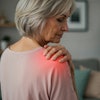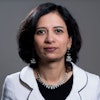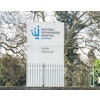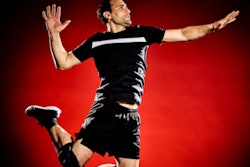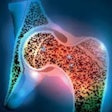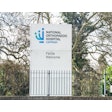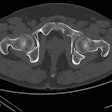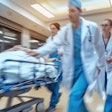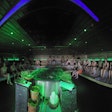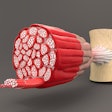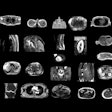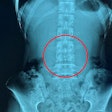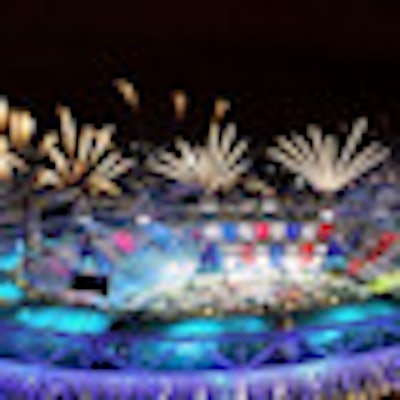
The first data on imaging usage at the London 2012 Olympics have emerged. Between 16 July and 6 August, Olympic polyclinic staff carried out 1,135 examinations, of which 564 were MRI, 259 were x-ray, 254 were ultrasound, and 58 were CT.
"It's been very busy here, and the workload probably peaked over last weekend when 52 MRIs were performed on a single day," said Finn Crotty, London 2012 project lead from GE Healthcare, in an exclusive interview with AuntMinnieEurope.com. "Having two MR systems onsite has been an absolute necessity."
 The Olympic Flame burns in the multipetaled, 8.5-meter-tall cauldron designed by Thomas Heatherwick and crafted in a workshop in Harrogate, U.K. The individual petals were carried in during the Athletes' Parade on 27 July, and each one will be removed at the end of the games and given back to the teams to take home, symbolizing a flower that blooms for the duration of the event. Image courtesy of London 2012.
The Olympic Flame burns in the multipetaled, 8.5-meter-tall cauldron designed by Thomas Heatherwick and crafted in a workshop in Harrogate, U.K. The individual petals were carried in during the Athletes' Parade on 27 July, and each one will be removed at the end of the games and given back to the teams to take home, symbolizing a flower that blooms for the duration of the event. Image courtesy of London 2012.
By the end of last week, around 26 radiologists and 34 radiographers had worked at the polyclinic. All of them are volunteers, and they must commit to work at the games for at least 10 days, although one dedicated staff member is scheduled to work for a total of 27 days.
"There was an element of the unknown because we are basically engineering from scratch and there was very limited information from Beijing in 2008," he noted. "I can honestly say there have been no big surprises so far, and everyone has been very positive about the technology. In line with the whole Olympics, there has been great teamwork among everybody, especially in how sports medicine specialists, radiologists, radiographers, and others have interfaced to provide medical services."
The new 5,000-square-meter four-story polyclinic building contains an estimated 7 million pounds (8.8 million euros) worth of imaging equipment, including a Discovery MR750w wide-bore 3-tesla MRI system, an Optima MR450w wide-bore 1.5-tesla MRI unit, a Discovery 750HD CT scanner, a Discovery XR656 wireless digital x-ray system, and Venue 40 and Logiq E9 ultrasound systems. After the conclusion of the 2012 Paralympics in September, the building will become a primary care clinic for the thousands of apartments in the Olympic Village, which along with the equipment are to be sold off by the London Organizing Committee of the Olympic and Paralympic Games (LOCOG).
 "When you see a 5-year-old kid dressed from head to foot in Team GB gear, you can't fail to be moved," Finn Crotty said.
"When you see a 5-year-old kid dressed from head to foot in Team GB gear, you can't fail to be moved," Finn Crotty said.
At any one time during the games, an average of eight GE Healthcare staff are on site, including engineers and application specialists. "Downtime has been minimal and where possible, we have proactively worked with LOCOG to schedule the engineering works for quiet times for the clinical service," according to Crotty.
Dr. Phil O'Connor, imaging lead for the games and a consultant musculoskeletal radiologist from Leeds, U.K., anticipated that about 600 MRI examinations would be carried out at London 2012, but the final total looks certain to be much higher.
During the Olympics, volunteers get free travel on public transport in London, but they receive no tickets to sporting events and must pay for their own accommodation. Most radiologists and radiographers are staying in an accommodation block at St. Bartholomew's Hospital, about a 15-minute walk from the Olympic Village. Each room costs 17 pounds (about 21.5 euros) a day. Most medical staff working in the U.K. National Health Service (NHS) has to use part of their annual holiday entitlement to work at the games because it is at the discretion of individual hospital trusts, or groups, as to whether an NHS employee will receive paid, professional leave.
 The so-called hockey-stick ultrasound probe has proved a valuable tool in musculoskeletal imaging at the Olympic polyclinic. Dr. Phil O'Connor uses it here. The probe's flexibility means it can get very close to the area of interest, and it's particularly useful for small joints.
The so-called hockey-stick ultrasound probe has proved a valuable tool in musculoskeletal imaging at the Olympic polyclinic. Dr. Phil O'Connor uses it here. The probe's flexibility means it can get very close to the area of interest, and it's particularly useful for small joints.During the Beijing games, nearly 22,000 medical encounters took place, of which about 45% were workforce-related and only 16% were athlete-related. The organizers performed 450 x-rays, 320 ultrasound exams, and 440 MR exams, and the MR service peaked at 59 exams on a single day.
Of the 858 injuries that occurred to athletes in Beijing and for which information is available, nearly 73% occurred during competition. About one-third of the total injuries resulted from contact with another athlete, 20% were due to noncontact trauma, 20% were due to overuse injuries, 13% were due to contact with an object (e.g., ball or bat), 5.5% were a recurrence of previous injuries, and the remainder was caused by equipment failure or playing/weather conditions. In almost half of the cases, the injury prevented the athlete from competition and training.
The plan is to produce an even more detailed analysis of workflow patterns and trends from London 2012. Outcomes will also be assessed.
 Fireworks are set off over the Olympic Stadium during the Opening Ceremony on 27 July. The closing ceremony takes place on Sunday evening, and the Paralympic Games will be held at the same venues from 29 August to 9 September. Image courtesy of London 2012.
Fireworks are set off over the Olympic Stadium during the Opening Ceremony on 27 July. The closing ceremony takes place on Sunday evening, and the Paralympic Games will be held at the same venues from 29 August to 9 September. Image courtesy of London 2012."Overall, it's been a wonderful experience. When you see a 5-year-old kid dressed from head to foot in Team GB gear, you can't fail to be moved. The public's excitement has rubbed off on all of us," said Australian-born Crotty, who has at least been able to lament over the lack of Australian medals at London 2012 with his compatriot, musculoskeletal radiologist Dr. David Connell, who has worked at the polyclinic.
